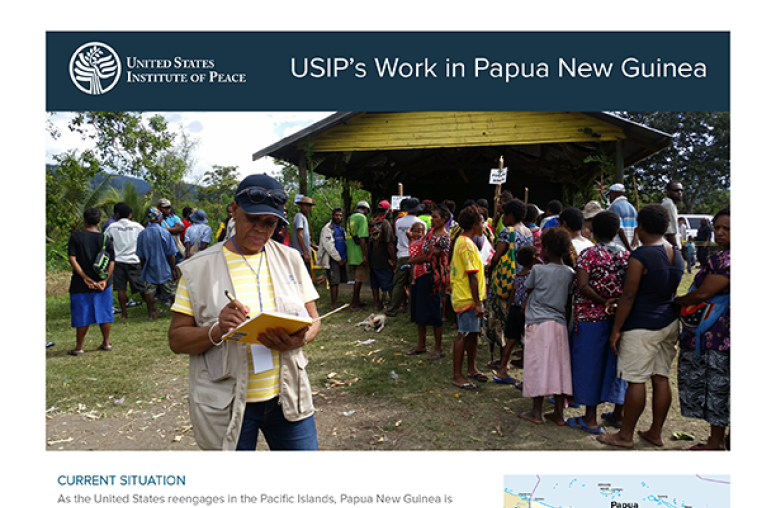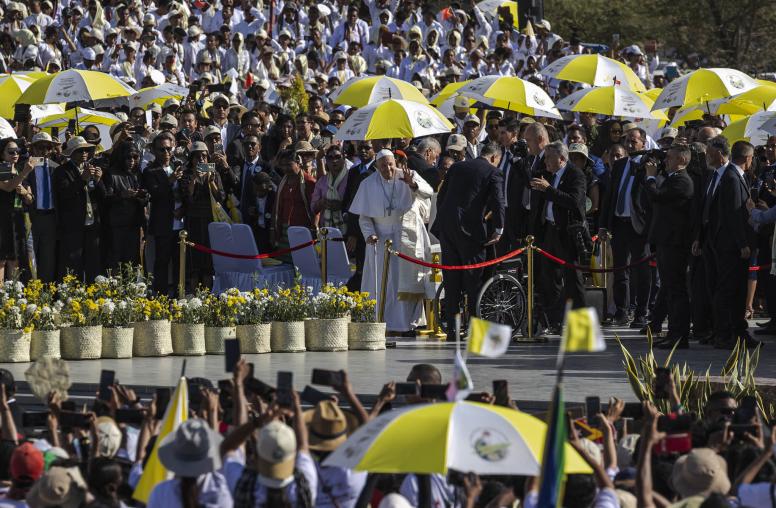What Can Bougainville’s Independence Movement Learn from Timor-Leste?
After decades of waiting, Timor-Leste’s independence came suddenly. Bougainville should be prepared for a similar trajectory.
Timor-Leste and Bougainville are two small, tropical island communities — one in Southeast Asia, the other in the South Pacific. While their culture and histories are distinct, they share a common political bond. They both voted overwhelmingly for independence in internationally sanctioned referendums, with Timor-Leste’s vote coming in 1999 and Bougainville’s in 2019. But only Timor-Leste, which is also referred to as East Timor, is now its own nation. What parallels does the path to self-determination in Timor-Leste hold for Bougainville as it looks to achieve the same goal?

It Starts Very Slow
History tells us a story about the winding path that countries like Timor-Leste take to independence and the role of international institutions and community. For Timor-Leste, independence came gradually — then suddenly. It’s worth remembering these two speeds when we think of Bougainville’s peace process and aspirations to become independent.
The initial road to independence in Timor-Leste was generations long. Chronologies of the history of Timor-Leste’s independence start in 1960, when the U.N. General Assembly added “Timor and its dependencies” to the list of non-self-governing territories.
Timor-Leste was then abandoned by Portugal after the 1974 Carnation Revolution. A civil war broke out between rival Timorese political factions, and the prevailing side issued a widely unrecognized unilateral declaration of independence (UDI) a little over a week before neighboring Indonesia invaded the region in late 1975.
The resulting Indonesian occupation was long and brutal. For 24 years, the Indonesian armed forces tried and failed to suppress Timorese aspirations for independence. The violence only made Timorese more focused and determined.
Similarly, the path to independence in Bougainville has been an intergenerational marathon. Bougainvilleans have been demanding independence since before Australia passed control of the territory to Papua New Guinea (PNG).
Bougainvilleans issued their first UDI from Papua New Guinea in September of 1975, just a little over two weeks before Papua New Guinea became an officially independent nation of its own. The UDI was unsuccessful — but it marked the beginning of a tumultuous relationship between Bougainville and the government in Papua New Guinea.
In 1988, lingering tensions and growing frustrations over the Panguna copper and gold mine triggered violence between the PNG Defense Force and Bougainville insurgent groups that lasted over a year. After a diplomatic agreement led to the initial withdrawal of PNG soldiers in 1990, a second and similarly unrecognized UDI reignited the violence in what became a 10-year civil conflict known as “The Crisis.” Deadly suppression by the PNG Defense Force failed to quell Bougainville insurgent groups, and the conflict is still bitterly remembered to this day.
It took years of talks to get to a peace agreement in August 2001, and the agreement’s proposed Bougainville independence referendum took another 18 years to organize. When Bougainvilleans finally were able to vote in 2019, 97.7 percent voted in favor of independence — offering a road map forward, even if it leads through obstacles in the PNG parliament.
Events Can Then Move Very Fast
“East Timor is our 27th province” was the Indonesian mantra after annexing the territory in 1976. That mantra held for 22 years, until May 1998, when the strongman President Suharto was ousted and his authoritarian New Order came to an end.
In the aftermath, “reformasi” became a public cry. And Suharto’s successor, President B.J. Habibie, promised gradual reform but moved swiftly on many fronts — including on Timor-Leste’s independence.
He authorized negotiations under the U.N. soon after he took power. Only a year later, Foreign Minister Ali Alatas signed an agreement with his Portuguese counterpart to hold a referendum on self-determination in Timor-Leste within months.
That August, the referendum was an unequivocal victory for independence, with 78.5 percent voting in favor. When reactionary forces in the Indonesian military tried to sabotage the process, the U.N. Security Council (UNSC) immediately authorized and deployed a multinational force to put a stop to it. Just six weeks later, the last Indonesian soldiers sailed from the port in the new capital Dili. A U.N.-guided transition period lasted until May 20 2002, when — after decades of stalemate and resistance — Timor-Leste became independent less than four years after President Habibie came to power.
Events Can Even Outpace the Policymaking Process
In 1998, President Habibie’s hold on power was tenuous and the world worried about the possible “Balkanization” of Indonesia, with Timor-Leste seen as the first of potentially many breakaway provinces.
The United States at the time was worried about the interests of American companies and their huge oil, gas and mining operations, often in peripheral provinces where unrest and dissatisfaction with Jakarta was greatest.
But with Timor-Leste on Australia’s doorstep, the Australian government was more focused. In a carefully crafted letter, then-Prime Minister John Howard proposed Indonesia consider giving the Timorese greater autonomy for a decade, then offer them a choice to go or stay as part of Indonesia. Australia policymakers deliberated on the letter’s contents for months.
The day after he received the letter, Habibie rejected it. The official Australian history of this period noted Habibie wanted the issue resolved quickly and “rapid independence for East Timor would be preferable to letting the issue drag on.”
PNG is at an Inflection Point
PNG has taken its time to resolve the question of Bougainville. In November, it will be four years since the people of Bougainville voted unequivocally for independence in a non-binding referendum that gave the PNG parliament the final decision-making authority. Since then, Bougainville’s quest for independence has been stuck in the PNG parliament. But not talking or thinking about Bougainville’s independence does not make it go away. The autonomous region is now 18 years old, and time has not diminished the desire of Bougainville’s leaders to run their own affairs. During three visits to Bougainville in 2022, I saw one minister address three different groups of local leaders and each time he mentioned “independence readiness.”
Bougainville’s leaders have declared they intend to become a new nation no later than 2027. As that date approaches, the priorities, incentives and calculations in the PNG capital of Port Moresby could change — and change quickly — with PNG’s prime minister as a key decision-maker.
We’ve already seen some movement on this front, as PNG’s Bougainville Affairs Minister Manasseh Makiba now says the referendum results will be tabled in parliament before the end of the year.
The process in Bougainville parallels that in Timor-Leste because one is based on the other. In Timor-Leste, the Indonesian legislature moved fast. Habibie’s policy direction was clear: accept the referendum. And the region’s independence was a minor issue compared to the other reforms that swept the country. After Timorese voted for interdependence in August 1999, legislators in Jakarta reversed the 1976 integration law by October, which gave the UNSC the green light to mandate the U.N. transitional administration.
All Independence Movements are Not the Same
Bougainville lacks the international profile and networks that Timor-Leste had.
Bougainville doesn’t have a figure like Jose Ramos Horta, who by 1999 shared a Nobel Peace Prize for his two decades of advocacy on the world stage and within international institutions. U.S. senators like Tom Harkin, Patrick Leahy and Edward Kennedy are not rallying behind Bougainville’s cause as they did Timor-Leste’s. The Timorese also had the Portuguese communities of Massachusetts and Rhode Island, whose sympathies for their cause connected it to U.S. domestic politics. Unlike many others, Bougainville does not have an expatriate community in the United States that can perform the same role.
However, Bougainville and the United States share unique historical ties from World War II. And Bougainville is an overwhelmingly Christian community with ties through missionaries to the Catholic and Adventist churches, who could help Americans find Bougainville on a map and rally support for its cause.
Additionally, in an era of growing strategic competition in the Indo-Pacific, Bougainville has a weight well beyond its estimated 300,000 people. As an independent nation, it would have a valuable vote in international bodies and could be subject to diplomatic overtures from competing interests looking to secure influence.
For example, as Timor-Leste moved toward independence, it was courted by China. In early 2000, Timorese leaders were given permission by Taiwan to use the former Taiwanese consulate as their headquarters and were gifted dozens of hand tractors and agricultural machinery. Months later, Timorese officials were invited to visit China and came back with the gift of a brand new foreign ministry building — sealing Timor-Leste’s diplomatic alignment with Beijing.
As the United States enters a deeper relationship with Papua New Guinea, it should be aware that greater international attention could be focused on Bougainville if forthcoming discussions about its independence get traction in Port Moresby. Until independence, much investment, aid and diplomacy would pass through the PNG capital. To be prepared, U.S. policymakers should be seeking greater discussions on the issue of Bougainville’s independence with counterparts in both Buka and Port Moresby. Meanwhile, other agencies — from USAID to PACOM — should be stepping up their engagement and planning for alternative scenarios beyond 2025.
Self-determination is About Realpolitik
Self-determination may be a universal value, but the right to become an independent nation is all realpolitik — for better or worse. In the last two decades, U.N. Security Council members states have allowed Timor-Leste and South Sudan to join the club of independent nations but not Kosovo or Western Sahara. This has nothing to do with the desires of the people in Pristina or Laayoune and everything to do with opaque geopolitical policy choices in Beijing, London, Moscow, Paris and Washington.
Timing was important for Timor-Leste. As the post-referendum crisis grew in early September 1999, Ramos Horta was able to deftly use an APEC meeting happening in New Zealand at the same to draw international attention. As then-President Bill Clinton flew across the Pacific to the APEC meeting, a quarter of Timor-Leste, some 200,000 people, were fleeing the violence.
The world’s media converged on Timor-Leste and APEC, and the international pressure to do something was immense. By the time Clinton arrived at the summit, Indonesia was no longer more important than Timor-Leste. U.S. shifted its policy — with President Clinton stating that if other countries’ boots were first on the ground, the United States would support a U.N.-mandated military intervention and American troops would have a “limited but important function” in the peacekeeping force. This go-ahead from the United States helped spark a prompt U.N. response to the Indonesian military’s sabotage efforts — and, in part, secured Timor Leste’s independence.
Lessons from Timor-Leste
What lies ahead for Bougainville? It will not be a carbon copy of Timor-Leste. Bougainville has a peace agreement, an internationally approved vote for self-determination and a pathway to independence. It has its own constitution, parliament, ministries and local government.
Institutionally, this is much more than the ashes from which Timor-Leste was built. Visit Arawa, Buin, Buka, Nissan or the many other villages in between and you will find Bougainvilleans at peace discussing and preparing for independence. If independence were to happen, the timing may not be perfect, especially for the international community. However, it would feel long overdue for the people of Bougainville.
*Jim Della-Giacoma is an international development consultant working across fragility and resilience in the Indo-Pacific. From 1999-2000, he was a political affairs officer working for the United Nations in Dili, Jakarta and New York.



